#ancient Macedonian inheritance
Explore tagged Tumblr posts
Note
Is it true that Alexander was against is baby sister Europa being killed? Or did he not know/have an opinion about it?
Olympias and the Murder of Europa
We don’t know when Olympias killed Kleopatra and baby Europa. Probably sooner rather than later; that is, on Alexander’s initial trip to south Greece, after he took the throne. By all accounts (and there aren’t many) he wasn’t in Pella when it happened. Plutarch tells us he was furious upon his return. He probably was, but not just because of the cruelty.
Tim Howe has an interesting theory in “Cleopatra-Eurydike, Olympias and a ‘Weak’ Alexander,” which suggests he’d intended to marry Kleopatra himself. This wouldn’t be the first example of a Macedonian king marrying the young widow of the prior king. Same thing happened with Archelaos who married the widow of his father Perdikkas II. (Ironically, she was also a Kleopatra.) Archelaos then killed his (unnamed) seven-year-old rival half-brother by Kleopatra. Although we can’t be 100% certain it’s the same woman, the likelihood is very high. We don’t know if the marriage occurred before or after he killed the boy. He then had a child himself by Kleopatra (which child, in turn, was murdered after Archelaos’s death and never took the throne).
Welcome to Macedonian politics.
In Alexander’s case, he wouldn’t have needed to kill the infant girl, as she was no threat. But by marrying his father’s widow, he could actively ‘perform’ his announced, “Only the name of the king has changed,” and secure political alliances before marching for Persia.
Yet a potential marriage on the horizon would be a very good explanation for Olympias’s action. On the face of it, the murder seems unduly vicious. An infant girl was, again, no threat—nor was Kleopatra herself. Perhaps Olympias did it purely for retribution, but she rarely acted for “mean” reasons. Killing Kleopatra suggests she was somehow still a threat. Why? Her uncle, Attalos, couldn’t be king (not an Argead), and her child was female. Why kill the widow?
Unless Alexander intended to marry her. What Alexander may have seen as good policy for him was a serious threat to Olympias’s own status. So she eliminated that option.
That would also explain Alexander’s apparent fury. Yes, he probably was horrified by the murder of an infant, but children under a year old already occupied liminal status, waiting to see whether they’d survive to their first birthday. I don’t mean that to be dismissive, but Europa’s life, or death, didn’t impact him much, politically. He may have seen her only a handful of times, so she was probably “nebulous” to him, his emotional reaction generic rather than specific.
His mother being responsible for the death of his father’s widow, however, DID impact him politically, upending any decision to marry her, plus requiring him to eliminate Attalos, who now had a blood feud with him. Supposedly, Attalos tried to tender an olive branch, but probably before he had news of his niece’s murder. So Alexander’s choice to have him assassinated (with Parmenion’s acquiescence) was a political choice necessitated by Olympias’s actions.
It would have been quite a mess, from a diplomatic POV. Olympias acted to safeguard her own security at court. But that, in turn, upset Alexander’s own plans, forcing him to reposition himself, leaving him desperate for Parmenion’s support, leading to high appointments for both Parmenion’s elder sons. It may have been the first serious (political) clash between mother and son. If normally, a mother’s fortunes in polygamous situations depended on her son’s, not always. Here, we see Olympias securing her own position by eliminating a rival…even if that then complicated her son’s political options.
The end result is that Alexander didn’t marry anybody before leaving for Asia.
Given his short life, that, in turn, resulted in a succession problem upon his death. Nobody could have foreseen as much in 336. Sometimes, you’re just trying to stay alive. But it had long-term consequences.
#asks#Olympias#Kleopatra-Eurydike#Cleopatra-Eurydice#Macedonian politics#ancient Macedonia#ancient Macedonian inheritance#Alexander the Great#Philip II of Macedon#Classics#polygamous courts
20 notes
·
View notes
Photo

Demosthenes
Demosthenes (c. 384 - 322 BCE) was an Athenian statesman who famously stood against Macedonian king Philip II and whose surviving speeches have established him as one of the greatest patriots and powerful orators from ancient Greece. He is not to be confused with the 5th century BCE Athenian general of the same name.
Early Life & Works
Born in c. 384 in Athens, Demosthenes' parents died while he was still only seven years old, and so he then lived under guardianship. Famously, at the age of 18, he prosecuted his guardians for wasting his inheritance, delivered his own speeches in court, and won the case. Studying under Isaeus and working as a speech writer (logographos) like his master, his first experience in court was as a prosecutor's assistant. We also know that in 358 BCE he was a grain-buyer (sitones). Then, from c. 355 BCE, he came to wider attention when he started to deliver his own speeches in the assembly of Athens.
61 speeches of Demosthenes - both public and private - have survived, along with the rhetorical openings (prooimia) for around 50 speeches and 6 letters. Probably, some of that number were speeches given by another orator by the name of Apollodorus but it is, nevertheless, a substantial amount of material. That is, even if, Demosthenes would have given many more speeches than that in his long and illustrious political career. Those that survive show a speaker who could use plain language and lucid argument to devastating effect. He was a master of metaphor but never overused it and, perhaps his greatest and most enduring quality, his work shows an absolute and convincing sincerity.
Continue reading...
44 notes
·
View notes
Text
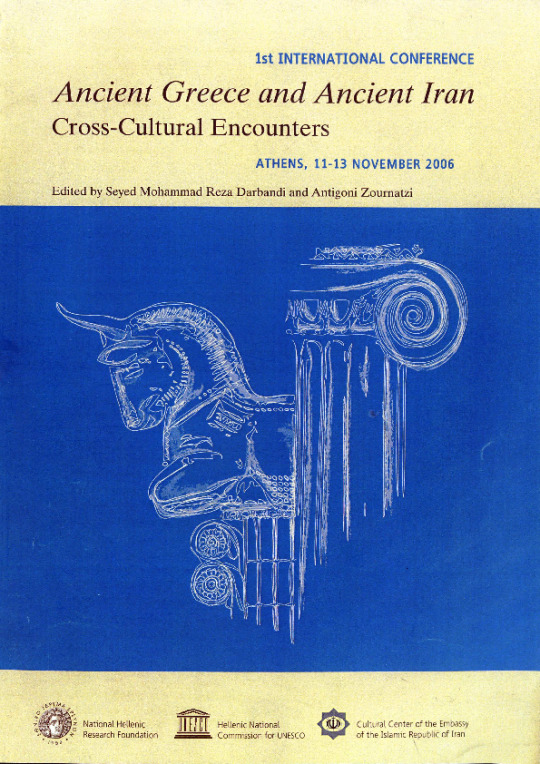
Ancient Greece and Ancient Iran: Cross‐Cultural Encounters 1st INTERNATIONAL CONFERENCE (ATHENS, 11‐13 NOVEMBER 2006) Edited by Seyed Mohammad Reza Darbandi and Antigoni Zournatzi National Hellenic Research Foundation Cultural Center of the Embassy of the Islamic Republic of Iran in Athens Hellenic National Commission for UNESCO Athens, December 2008
Description The extraordinary feats of conquest of Cyrus the Great and Alexander the Great have left a lasting imprint in the annals of world history. Successive Persian and Greek rule over vast stretches of territory from the Indus to the eastern Mediterranean also created an international environment in which people, commodities, technological innovations, as well as intellectual, political, and artistic ideas could circulate across the ancient world unhindered by ethno-cultural and territorial barriers, bringing about cross-fertilization between East and West. These broad patterns of cultural phenomena are illustrated in twenty-four contributions to the first international conference on ancient Greek-Iranian interactions, which was organized as a joint Greek and Iranian initiative.
Contents
Preface (Ekaterini Tzitzikosta)
Conference addresses (Dimitrios A. Kyriakidis, Seyed Taha Hashemi Toghraljerdi, Mir Jalaleddin Kazzazi, Vassos Karageorghis, Miltiades Hatzopoulos, Seyed Mohammad Reza Darbandi, Massoud Azarnoush, David Stronach)
Introduction (Seyed Mohammad Reza Darbandi and Antigoni Zournatzi)
Europe and Asia: Aeschylus’ Persians and Homer’s Iliad (Stephen Tracy)
The death of Masistios and the mourning for his loss (Hdt. 9.20-25.1) (Angeliki Petropoulou)
Magi in Athens in the fifth century BC? (Kyriakos Tsantsanoglou)
Hājīābād and the dialogue of civilizations (Massoud Azarnoush)
Zoroastrianism and Christianity in the Sasanian empire (fourth century AD) (Sara Alinia)
Greco-Persian literary interactions in classical Persian literature (Evangelos Venetis)
Pseudo-Aristotelian politics and theology in universal Islam (Garth Fowden)
The system Artaphernes-Mardonius as an example of imperial nostalgia (Michael N. Weiskopf)
Greeks and Iranians in the Cimmerian Bosporus in the second/first century BC: new epigraphic data from Tanais (Askold I. Ivantchik)
The Seleucids and their Achaemenid predecessors: a Persian inheritance? (Christopher Tuplin)
Managing an empire — teacher and pupil (G. G. Aperghis)
The building program of Cyrus the Great at Pasargadae and the date of the fall of Sardis (David Stronach)
Persia and Greece: the role of cultural interactions in the architecture of Persepolis— Pasargadae (Mohammad Hassan Talebian)
Reading Persepolis in Greek— Part Two: marriage metaphors and unmanly virtues (Margaret C. Root)
The marble of the Penelope from Persepolis and its historical implications (Olga Palagia)
Cultural interconnections in the Achaemenid West: a few reflections on the testimony of the Cypriot archaeological record (Antigoni Zournatzi)
Greek, Anatolian, and Persian iconography in Asia Minor: material sources, method, and perspectives (Yannick Lintz)
Imaging a tomb chamber: the iconographic program of the Tatarlı wall paintings (Lâtife Summerer). Appendix: Tatarli Project: reconstructing a wooden tomb chamber (Alexander von Kienlin)
The Achaemenid lion-griffin on a Macedonian tomb painting and on a Sicyonian mosaic (Stavros A. Paspalas)
Psychotropic plants on Achaemenid style vessels (Despina Ignatiadou)
Achaemenid toreutics in the Greek periphery (Athanasios Sideris)
Achaemenid influences on Rhodian minor arts and crafts (Pavlos Triantafyllidis)
Historical Iranian and Greek relations in retrospect (Mehdi Rahbar)
Persia and Greece: a forgotten history of cultural relations (Shahrokh Razmjou)
The editors Seyed Mohammad Reza Darbandi is General Director of Cultural Offices of the Islamic Republic of Iran for Europe and the Americas. Antigoni Zournatzi is Senior Researcher in the Research Centre for Greek and Roman Antiquity, National Hellenic Research Foundation. Her work focuses on the relations between Achaemenid Persia and the West.
The whole volume can be found as pdf on:
10 notes
·
View notes
Note
What's an underrated event that should be discussed more about Ancient Greece and what's an overrated one that people constantly talk about? Also, who do you think is an underrated greek figure and who is overrated?
I think I'm way out of my depth with this question, I don't feel like I know enough of history to reply properly.
I think people should stop talking about classical sparta as this super warrior state and acknowledge how horribly messed up it was. And stop using it in videogames and movies. just stop. Also less about classical athens itself, more about how the ancient greeks colonized nearly everything they could reach by boat but didn't care at all for the north or large expanses of land (before alex that is). I also think not enough attention has been given to the battles of Philip (alex's dad) across greece. He was the one who obliterated the sacred band of thebes and paved the way for alex's unbridled ambition. Without his reform of the macedonian army and his victories, alexander wouldn't have inherited such a huge power to command. I guess these aren't rly events but ahh.
My first instinct for overrated figure is alexander but I also get it, impressive war things and imperialism etc etc, so I'm not gonna say alex even though I'm sick and tired of him. And I'm not gonna say alcibiades is underrated bc I already talk way too much about him and it will go to his head.
Instead, I'm gonna pick my favorite underrated guy, who isn't even greek, but a hellenized syrian, Lucian. His stories are insane. Definitely would love to see them as psychedelic animated movies. Love u Lucian <3 .
Oh also the only spartan with rights, Brasidas. More brasidas. We have even found his potential remains.
Also epicurus and other lesser known philosophers and sophists. Gorgias my boy. Also how crazy and culty the pythagoreans were.
oh oh also Pausanias the guy who travelled all over the place and documented everything like an extremely dedicated vlogger, we know so many crazy things thanks to him. He's underrated too. I don't see enough pausanias love.
ALSO ARCHIMEDES. HE BUILT MACHINES. RLY COOL GUY.
okay im done
22 notes
·
View notes
Text
Wrenn Lucifel Rhee-Merlow

Nicknames: Wrenny bear, Merlow Pup, Taeseong’s whelp, Angelface, “The small Taeseong” Marital Status: Widowed Occupation: Assassin for hire Species: Half demon/half witch Gender,Pronouns: cis-male, he/him Race/Ethnicity: European, Japanese, and Korean mix Religion: *shrugging emoji* Languages: English, Latin, Greek, Ancient Macedonian, German, Welsh, French, Italian, Japanese, Mandarin, Demonic, Fae, and some Angelic Place of Birth: England Date of Birth: 21st of May, 16XX Age: 400+ (appears to be in early/mid 20s) Orientation: pansexual/panromantic
APPEARANCE
- Hair colour/length: ash brown, layered, and long enough for him to make a lil’ ponytail in the back - Eye colour: formerly bright moon-silver, now “tarnished” silver containing bits of dark gray and flecks of brown - Height: 5′6 - Scars: Many across his body, more focused on his abdomen and back and especially on his arms - Moles/Markings/Tattoos: He has the old Merlow family crest burnt tattooed onto his ankle
PERSONALITY
- Likes: cooking, trying new foods, boba drinks, his family, his scraggly plant - Dislikes: Hatius, people who hurt his family - Virtues: confident, charming, devoted, well-read, protective - Vices: vain, loyal-to-a-fault, obsessive, possessive
- VOICE: Soft and soothing, always notably gentle even when he yells. Has an Estuary English accent.
ABILITIES
Supernatural
- Merlow family magic: Potent dark/death magic inherited from his family and cultivated by training with Charidynn Merlow - Blood magic - Necromancy - Death Aura: because of his magic, his aura can actually eat away at life around him, especially when he doesn’t watch it - Rhee Blood Curse: Turns into a chimera-like beast, though for some reason he always gets stuck mid-transformation. The Curse grants him an increase in strength, physical endurance, and heightened animal-like sense. However, the more he endures the pain of the transformation, the less of him is there
Non-supernatural
- cooking - singing - violin - ballroom dancing
#{ eyes of an angel } wrenn#(( finally working in some proper bios and things and today and tomorrow is dedicated to Wrenny bear ))
2 notes
·
View notes
Text
Chiefs Kingdom Patrick Mahomes And Trvis Kelce Super Bowl Champions 2023 Skyline Shirt
Chiefs Kingdom Patrick Mahomes And Trvis Kelce Super Bowl Champions 2023 Skyline Shirt
Ukraine’s flag was officially adopted in 1992, although the Chiefs Kingdom Patrick Mahomes And Trvis Kelce Super Bowl Champions 2023 Skyline Shirt in contrast I will get this blue and gold colours are alleged to have been used as early as the days of Kievan ‘Rus to symbolise the country. Officially, they represent the blue sky and golden fields of grain that characterise the country of Ukraine. The flag of Bosnia & Herzegovina was designed as a deliberate attempt to break from the past and create a fresh start, so making it completely unlike the flags of Former Yugoslavia and its component states was quite intentional. The triangle represents the three communities of the nation (Serb, Croat, Bosniak), and the colours and the stars were deliberately based on the flag of the European Union to show where Bosnia-Herzegovina sees its future.

Buy this shirt: Chiefs Kingdom Patrick Mahomes And Trvis Kelce Super Bowl Champions 2023 Skyline Shirt
Home: Meredpremium
==================================
Official Chiefs Kingdom Patrick Mahomes And Trvis Kelce Super Bowl Champions 2023 Skyline Shirt
Yellow for the Chiefs Kingdom Patrick Mahomes And Trvis Kelce Super Bowl Champions 2023 Skyline Shirt in contrast I will get this triangle was also chosen specifically because it wasn’t a colour that was already associated with any of the Balkan nations. Curiously, the original proposal for the flag used the light blue of the UN flag; this was rejected and changed to the dark blue of the EU flag – I don’t know if this choice was political or aesthetic! Bosnia & Herzegovina’s flag was deliberately made as dissimilar to other flags from the region as possible, to symbolise a new beginning. Macedonia’s flag, as Mitar says, is based on the symbolism of ancient Macedonia: specifically, the sun pattern carved into the tomb of Philip, Alexander the Great’s father. This claim to have inherited the Macedonian heritage has angered the Greeks ever since. Interestingly, the Macedonian national anthem which refers to the “new sun of liberty” was composed as long ago as 1943, so this isn’t a new association. Macedonia’s flag uses the symbolism of the ancient kingdom of Macedonia, in order to lay claim to the heritage of Alexander the Great.

Buy this shirt: https://meredpremium.com/product/chiefs-kingdom-patrick-mahomes-and-trvis-kelce-super-bowl-champions-2023-skyline-shirt/
Home: Meredpremium - Meredpremium – Luxury Clothing & Accessories for men and women in the USA
==================================
Top Chiefs Kingdom Patrick Mahomes And Trvis Kelce Super Bowl Champions 2023 Skyline Shirt
Ukraine’s flag was officially adopted in 1992, although the Chiefs Kingdom Patrick Mahomes And Trvis Kelce Super Bowl Champions 2023 Skyline Shirt in contrast I will get this blue and gold colours are alleged to have been used as early as the days of Kievan ‘Rus to symbolise the country. Officially, they represent the blue sky and golden fields of grain that characterise the country of Ukraine. The flag of Bosnia & Herzegovina was designed as a deliberate attempt to break from the past and create a fresh start, so making it completely unlike the flags of Former Yugoslavia and its component states was quite intentional. The triangle represents the three communities of the nation (Serb, Croat, Bosniak), and the colours and the stars were deliberately based on the flag of the European Union to show where Bosnia-Herzegovina sees its future.

Yellow for the Chiefs Kingdom Patrick Mahomes And Trvis Kelce Super Bowl Champions 2023 Skyline Shirt in contrast I will get this triangle was also chosen specifically because it wasn’t a colour that was already associated with any of the Balkan nations. Curiously, the original proposal for the flag used the light blue of the UN flag; this was rejected and changed to the dark blue of the EU flag – I don’t know if this choice was political or aesthetic! Bosnia & Herzegovina’s flag was deliberately made as dissimilar to other flags from the region as possible, to symbolise a new beginning. Macedonia’s flag, as Mitar says, is based on the symbolism of ancient Macedonia: specifically, the sun pattern carved into the tomb of Philip, Alexander the Great’s father. This claim to have inherited the Macedonian heritage has angered the Greeks ever since. Interestingly, the Macedonian national anthem which refers to the “new sun of liberty” was composed as long ago as 1943, so this isn’t a new association. Macedonia’s flag uses the symbolism of the ancient kingdom of Macedonia, in order to lay claim to the heritage of Alexander the Great.
Buy this shirt: Click Here to buy this Chiefs Kingdom Patrick Mahomes And Trvis Kelce Super Bowl Champions 2023 Skyline Shirt
Home: https://meredpremium.com/
0 notes
Text
Sparta was a politically and socially conservative society in that it insisted as a wide group that it never change. This is part of the reason Sparta became extremely weak later in ancient Greek history. It wasn’t flexible enough to adapt to the changes around it. Around the time that Sparta began enslaving it’s neighbors there were possibly around 9,000 Spartan citizens. This wasn’t a lot. And it mostly fell from there. The parental and property qualifications for citizenship were extremely strict. The Spartans allowed their women to exercise and marry later and inherit property not because they cared about them but because they were constantly paranoid about their declining population and wanted to keep their women physically and mentally strong so they’d live long enough to have more children.
Spartan society was ruled by paranoia. Of their declining population, of their large slave and freedmen populations, of the other Greek states starting slave uprisings in an effort to overthrow them, of the possibility that their children wouldn’t think and act exactly the same way that they and all their ancestors did.
By the Roman era they had been reduced to a shell of their formal selves, acting as a glorified tourist trap and boarding school for Roman elites.
Athens and Thebes and the other Greek cities had their own issues. They were terrible to women, they bickered with each other over petty issues. But ultimately they survived into the Macedonian and Roman eras as cultural centers because they had their own skills and the ability to adapt. Sparta was doomed to rot and decay as a society from the start because it was built on exploitation, paranoia, and a resistance to change or outside influence. Stop wishing we were more like the Spartans they were losers
Modern “alpha males” like to think they’d be the brave warriors of ancient Sparta but statistically they’d be far more likely to be part of a slave class running all the farms for and being hunted for sport by said warriors. And even if they were a Spartan citizen they likely wouldn’t last one day what with all the singing, dancing, vinegar drinking, and gay sex. If you wanted to have sex with your wife before the age of 40 you’d be expected to sneak out to her in the middle of the night and not get caught. Also Ancient Greek men were far more willing to weep openly than modern western alpha males.
A lot of Spartan life was centered around being afraid of their large slave class because they depended on them so heavily that they had no skills of their own aside from politics and exercising and singing and dancing. One or two large scale slave revolts would cripple their entire society. They didn’t know how to farm or weave or blacksmith or have a real job and they certainly didn’t have intricate rituals that allowed them to touch the skin of other men. They just did it. If anything they had intricate rituals that allowed them to touch women.
The fragile masculinity of ancient Sparta doesn’t scale one to one with the fragile masculinity of today. In fact, a lot of the aspects of one would shatter the other. A lot of far right alpha male bros who worship ancient Sparta would explode when they realized that Spartan leadership was more interested in being a neutral third party to negotiate terms between other Greek city states and touching each other’s butts than actually going out and going military stuff.
So many masculine manly men think they understand Sparta. That they all fought naked and never lost a battle and were the only ones who fought back against Persia. When a bunch of other Greeks were there at Thermopylae, the Spartans did wear armor, and the 300 odd soldiers accounted for the number of Spartan citizens there. Not the number of free men who didn’t qualify for citizenship or the enslaved soldiers who were forced to stay whether they wanted to or not or the thousands of other soldiers from other Greek cities that were there.
Unless you hunt poor people for sport and like having sex with your bros as a bonding activity and enjoy being politically like Switzerland and don’t have a real job, don’t compare yourself to Sparta. If anything a modern day Spartan would be a corrupt easily bribed bisexual trust fund baby running for a conservative political office.
376 notes
·
View notes
Note
I suppose the closest real life equivilent to that would be the Moorish influence in parts of Spain.
the welsh influence is mostly found in the dornish marches and the dornish resistance to targaryen conquest, not the people or their culture.
Sorry to tell u, but he meant ONLY in CULTURE. They're similar to black people due to their culture, not appearence. He based Valyria on Ancient Egypt, but guess what, the Valyrians were white.
I hope you understand it now.
he based valyria on ancient rome and the targaryens on the ptolemaic dynasty (who were macedonians), not the ancient egypians.
sorry but he based the dornish people and their culture on the moors and palestinians. you can tell by the fact that the dornish practice similar inheritance laws as muslims which is what made them distinct from other 6 kingdoms.
28 notes
·
View notes
Text
Greece: A historical essay - Part 1/4
On the 25th of March 2021, the people of Greece celebrate their independence day. This year is especially important because it is exactly 200 years since the outbreak of the revolution (1821). I decided to honor my country and its history with a (relatively) detailed post.
Most people around the world already have knowledge regarding ancient Greece, so I will be brief here.
ANCIENT AND ARCHAIC GREECE:
between 3000 and 1100 B.C. roughly, there existed the Minoan civilization of Crete. We know little about them besides their elaborate palaces (anaktora), intricate plumbing systems and wonderful frescoes. They used the linear A in their writing, which remains undeciphered to this day. This civilization was one which traded with the outside world. Being an island, they also did not have many fortifications, which might have contributed to their downfall. There are 2 main theories as to their decline: Invasions from the mainland Mycenaeans or the major volcanic eruption of Santorini around that time.
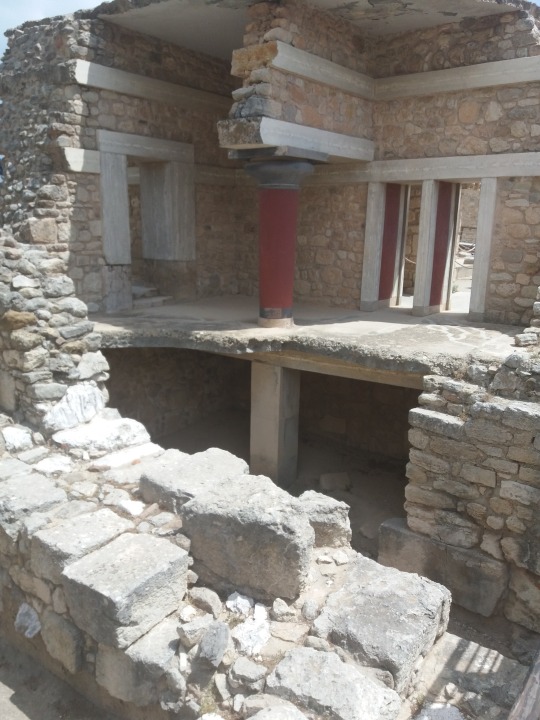
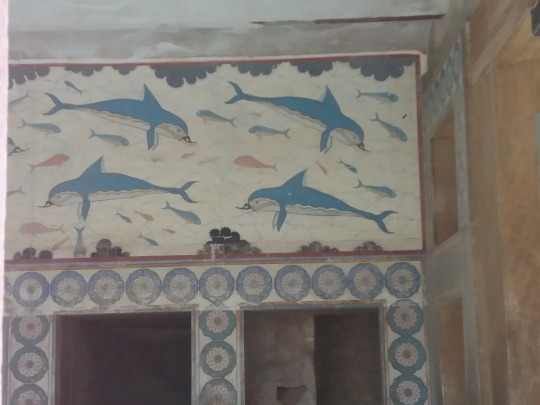


Pictured above: 1) a partially destroyed room, allowing a peek inside 2) some restored frescoes 3) an outer room 4) A showcase of the simple and geometric, yet elaborate and colorful, structure of the building. All of these pictures are from the Palace of Knossos.
The next civilization to succeed them were the aforementioned Mycenaeans, who thrived between 1650 and 1200 B.C. They originally lived in the Peloponnese peninsula, on the southern tips of mainland Greece. It appears that they invaded and subjugated the Minoans at some point. They used linear B for their alphabet, which has successfully been deciphered and is our first indication of archaic or proto-Greek. The later tales of Homer (Odyssey and Iliad) are set in the 1200s and involve Mycenaean legendary heroes and rulers.
They were organized in independent and semi-independent city-state kingdoms, crafted bronze weapons and were a war-like people. Around 1200, we see an increase in fortifications around their settlements and the remains of their palaces carry signs of having been burned. This implies that they, too, fell to an invading force which had been threatening them.
The Minoans and Mycenaeans appear to have both used a centralized “manorial” or palatial economic system, which revolved around their grand palaces.
After their fall came the dark age of ancient Greece, which lasted from 1100 to 750 B.C. As implied by the name, we have very little information about this time. Pottery lost its elaborate design and became merely geometric, the linear B alphabet stopped being used, settlements were much smaller and fewer in population.
One other notable involvement is the arrival of the Doric tribes to the Greek mainland, displacing and possibly mixing with the Mycenaeans.
CLASSICAL GREECE:
This is the ancient Greece everyone knows and loves. The Dorians were not the only ethnic group of that time, with them appeared the Ionians, Achaeans, and Aeolians. In myth, these are all relatives who came from the same ancestor, Hellen (not the famous Helen of Troy, but instead a male patriarch from Thessaly).
The Achaeans might have had a relation to the Myceneans or have existed alongside them to some degree, This is only a hypothesis though.
The Dorians were the direct ancestors of the Spartans and Corinthians, among other smaller states of the Peloponnese.
The Ionians are best remembered as the ancestors of the the Athenians but also their many coastal and islander allies, including the region of Ionia (modern Smyrna/Izmir region) in Asia Minor.
The Aeolians lived in modern-day Thessaly and were the most numerous of the Greek groups. During the Doric invasion, some of them fled to the island of Lesbos and the region of Aeolis (which they named) in Asia Minor.
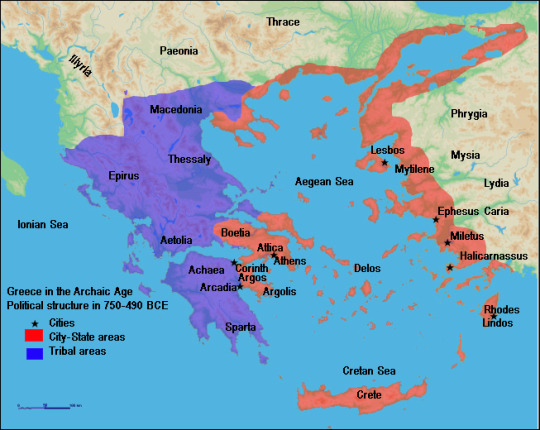
During this period we see the early foundations of what would evolve into the ancient Greek city-state model, as most imagine it, as well as the government forms of Classical Greece - Oligarchy, Democracy, Tyranny. These forms of government acted as ancient ideologies of sorts, to a degree.
In Sparta, Lycurgus implemented the reforms which led to the highly militarized, disciplined, regimented and isolationist Spartans of the Classical period.
In Athens, there was a succession of reformers who led to the establishment of Democracy. First was Dracon, the least democratic of all and whose laws give us the modern definition of the word “Draconic”, afterwards we have the moderate Solon, who can be credited with the foundations of Democracy and maintaining a balance between the aristocratic wealthy and the common poor. There was a brief interruption to democracy between 561 - 510 B.C. as the leader of the Democratic faction, Peisistratus, took the reins of power as a Tyrant (back then, the word had a neutral or even slightly positive connotation, along the lines of “benevolent dictator/enlightened autocrat). The laws and customs of Athenian Democracy were kept in place during those years and were able to blossom after the end of the tyranny. Cleisthenes was the next in the line of reformers. A radical democrat, he greatly expanded the power of the poorer citizens. All of these reforms led directly to the Athenian Democracy inherited by Pericles right before the Peloponnesian war and during the zenith of Athenian power, wealth and culture through its leadership of the Delian League.
Before that though, there were the Persian wars, which started when the coastal city-states and former colonies of Asia Minor cried for help to the Greek mainland, in an effort to avoid complete annexation by the Persian empire.
This led Greece to band together against the threat of the Persians and beat them back, after many losses and much hardship. This is considered the main grand epoch of the classical era and bound them all together as “Hellenes” for the first time.
Greece was not a place of long-lasting peace and alliances though. Soon after, the Athenian populist democratic politicians promised their people great opulence, which they could only ensure by taking from the common fund of the Delian League and using that money on their city. Thus Athens prospered at the expense of its supposed allies, leading to the era of Athenian Hegemony around the 5th century B.C. (Sparta used to be the hegemon before them, around 650 B.C.). This all lead directly to the Peloponnesian war of 431 - 404, where the Spartans emerged victorious after protracted campaigns and battles, gaining the title of “liberators” for dismantling the Athenian hegemony and liberating their tributaries.
During this period we also have the beginning of Greek philosophy as we know it, with the activity of Socrates. Pre-Socratic philosophers were generally natural scientists and cosmologists, he was the first to deal with moral and political philosophy, changing the term forever. Plato was his student, who famously wrote his own political system in “The republic” and unsuccessfully tried to implement it in Syracuse. Aristotle was the student of Plato and became the founder of Mixed government and Classical republicanism (as it was later known and developed later in the renaissance), he was also the teacher of Alexander the Great, the famous Greek-Macedonian king who created an empire.
Sparta’s attempt at aiding oligarchic tyranny in Athens, with the conclusion of the war, failed and Athens returned back, somewhat weak but still great, after only a few years. The next hegemon to take the title were the Thebans, the third most powerful city-state of the era. They held it for a short while in the 3rd century, until Alexander the Great’s father, Philip II, took that title from them, laying the groundwork for the later conquests of his son.
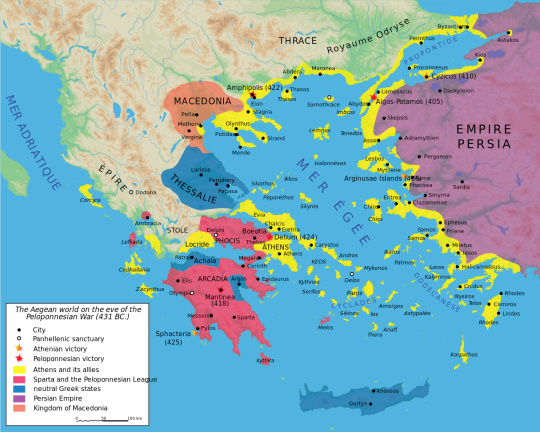
Alexander defeated the Persians, conquered Egypt, Babylon, Asia minor, Persia itself and finally modern-day Pakistan and Afghanistan, reaching the Indus river, where he finally met his equal at the hands an Indian kingdom and was forced to return back to Babylon, where he died.
His empire fractured into four successor states and Rome met little resistance, fighting only Epirus and a weakened Macedon, in their conquest of Greece.
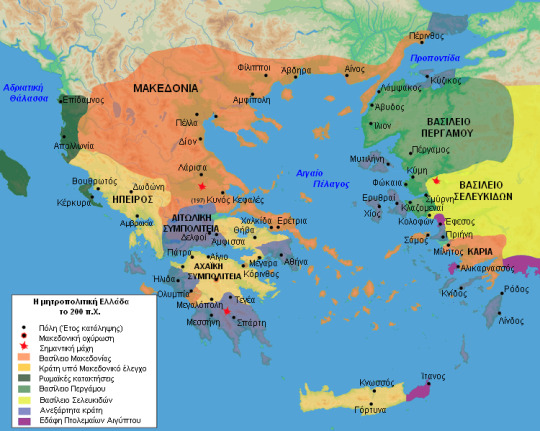
Pictured above: Greek states around 200 B.C.
Bright yellow: Seleucids
other Yellow: Achaean League, Epirus and states under Macedonian influence
Dark Blue: Aetolian League and Independent states
Orange: Macedon
Dark Green: early Roman conquests
Light Green: Kingdom of Pergamum
Purple: Ptolemaic (Egyptian) holdings
12 notes
·
View notes
Text
Alexander III “The Great”, King of Macedon (356-323BC) Part 1: The lay of the land...
His name conjures up all kinds of images and associations and the details of his life which spanned just shy of 33 years are far too expansive to be condensed into one post, so we’ll divide it into a few parts with a summary focus on what brought him to historical attention, his military conquests and some of his lasting impacts on culture and history. First a bit of personal and geopolitical background are necessary.
Alexander was born in July of 356 BC in what is the city of Pella in the ancient Kingdom of Macedon in modern northern Greece. His father was the then reigning King of Macedon, Philip II and his mother was one of Philip’s wives Olympias, a princess from another Greek kingdom, Epirus. Ancient Greece was divided into city-states or polis or various small petty kingdoms without a unified rule in the 4th Century BC. In centuries prior, Greece was dominated by two cities with two different systems of government and two different military traditions. One was Athens, a direct democracy with an advanced and powerful navy and the other was the largely land based diarchy (two co-ruling kings) of Sparta, which was famed for its infantry and harsh military indoctrination with a reputation as an almost unbeatable force in the Classical Greek world. Both played an important role in establishing Greek culture, philosophy, art, religion, military and government, all of which would contribute to modern Western Civilization.
Athens and Sparta were at times friendly but often rivals and most especially in the 5th Century BC with the invasion of Greece by the great superpower of the day in Eurasia, the Achaemenid Empire, better known as the Persian Empire from Iran. The Persian Empire spanned from the Indus River valley in modern Pakistan and India across Central and Western Asia, the Middle East, Northern Africa and Southern Europe, it was multiethnic, multilingual, multireligious, cosmopolitan and very influential on governance. It was centered in Iran, by the Persians, an Iranian people of the diverse Indo-Iranian ethnolinguistic group that overtook many others and expanded to become the predominant power of its age, probably in the entire world. The Greek or Hellenic world was on Persia’s western fringe, it was a tributary portion, subject to the Persians but with a modicum of independence. Persia’s provinces were divided into satrapies, ruled by royal governors called satraps. Persia invaded Greece under Xerxes I, its Shah or King of Kings in 480 BC. This united Greece and was famed for the stand of the Greek force, namely the 300 Spartans at the Battle of Thermopylae, which though a Persian victory was costly in lives and time, delaying the Persians. Eventually the Persians retreated due to rebellion back east and the force that remained was defeated by the Greeks, giving the Greeks breathing space to maintain their independence. In the wake of this victory though Athens and Sparta and their various other Greek allies turned on each other forming rival camps in the Peloponnesian War which saw Sparta defeat Athens and become the most powerful faction in Greece.
Meanwhile to the north in the highlands, Macedon was remote and rustic for a Greek kingdom, it was viewed as a backwater by its southern neighbors and some did not consider it Greek at all. Though they are believed to have spoke their own dialect of Greek, worshipped in the same polytheistic religion as Greece and shared certain other cultural traits with the southern Greeks. Nevertheless their proximity to the barbarian tribes of the Balkans, the Thracians, Dacians and Illyrians made them some what of a halfway point between “civilized” Greece and outright barbarians. However, the ruling dynasty into which Alexander was born, the Argead claimed descent from the legendary hero Heracles or Hercules and from there Zeus, God of Thunder and supreme on the Greek Pantheon of Olympian Gods. They were famed for their military tradition, including cavalry and their infantry. It was really Alexander’s father Philip who introduced the innovations to Macedon’s military that Alexander would perfect in later battles.
Their reforms were a result of technology, regimented drilling and a doctrine of combined arms, something most Greek military traditions up to that point ignored. Typical emphasis was on one branch of the military, in Athens it was naval warfare, in Sparta, a strong infantry and Thessaly a strong cavalry. Macedon lacked naval power at the time but it sought to emphasize both strong cavalry and infantry tactics in combined usage, one supporting the other throughout the battle. Philip adopted tactics from his enemies, including the light infantry tactics of the Thracians, the light cavalry of the nomadic horse archer Iranian Scythians including their flying wedge tactic. Most famously, Philip helped innovate a new technological and tactical formation, the phalanx.
The phalanx was a formation of regiments of heavy infantry using long spears called the sarissa, typically 18-20 feet long in units numbering 256 men each armed with a speared pike that was light in construction but due its length could keep the enemy at bay. Phalanxes were both defensive and offensive in nature. Its long spears meant it could defend itself at greater range in melee, deflecting cavalry and infantry charges head on and by going on the offensive and marching in formation, the phalanx could deploy to hold or press open the enemy line by fixing it into place in such a way that a gap could open for the Macedonian cavalry to exploit with its flying wedge formation, typifying the use of combined arms.
Macedonian troops were drilled constantly, almost as much as Spartans but in a much looser more flexible and adaptable doctrine, making them more well rounded than their Spartan counterparts. Philip would conquer the famed city of Thebes as well as defeat several barbarian tribes and went onto conquer much of Greece and got Athens to make peace but he never took on Sparta, nor did Alexander. Nevertheless, with Macedon now the dominant power over Greece, Philip was named Hegemon of the Hellenic League, making him in effect the ruler of a mostly unified Greece. His goal was to next invade the Persian Empire which was on the decline but he was assassinated by his own bodyguard.
At age 20, Alexander took the throne of Macedon, becoming the king but his rule was in jeopardy, Alexander, however was a learned young man, thanks to his father hiring the famed Aristotle to be Alexander’s childhood tutor. This well rounded classical education combined history, geography, mathematics, biology, philosophy and literature, all things which Alexander came to appreciate and support, but his military training was all from his father and his father’s trusted generals, many of whom Alexander now inherited himself.
Alexander would have to prove himself and his kingdom worthy of his father’s legacy while at the same time forging his own name. He defeated both Thracian tribes to the north in modern Bulgaria and other Greek states, which like his father named him Hegemon and in 334 BC when he crossed the Hellespont from Greece into Asia Minor (modern Turkey), his forces would embark on a ten year campaign that would change the world and one from which he would never return home...
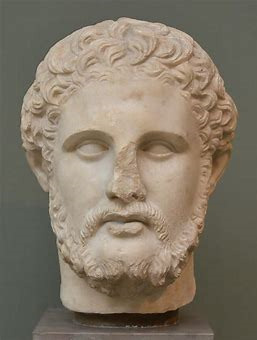
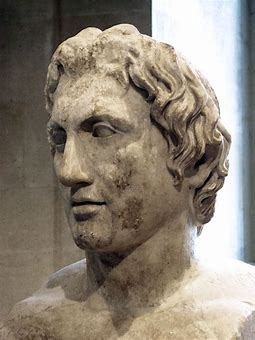
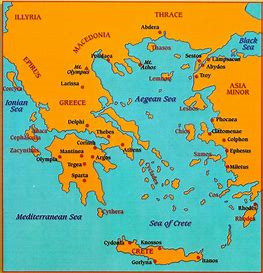
#Alexander the Great#philip ii of macedon#macedonia#ancient greece#ancient world#military history#persian empire#combined arms#military tactics#phalanx#sarissa#athens#sparta#aristotle#classical greece#4th century bc#5th century bc
10 notes
·
View notes
Text

hello ! shay here and this is my original vamp dru. she has the start of a pinterest board here (x) and has a page for her overall stats here (x). i am still working on a connections page for her and am wide open for any plotting suggestions. i’m so excited to bring her here and write with you all !!!

EMILIA CLARKE, CISFEMALE, SHE/HER, ORIGINAL VAMPIRE / deep in the pacific northwest lives DRUSCILLA ‘DRU’ FIDELE AGOSTI. i heard they’ve been living there for nineteen years and last saw them hanging around sacred heart cathedral, i think they might’ve been reminiscing on a family long buried. at two thousand one hundred and eighty one years old, druscilla doesn’t look a day over thirty. everyone around here always associates them with the dry rasp of bat wings on stone, red lips in a darkly lit room, and the drape of brown curls over brass bed posts. hope they enjoy their stay !
(TW: MURDER, RAPE, PROBABLE HISTORICAL INACCURACY)
Born in 181 BC, Druscilla Fidele Agosti was the oldest of four children born to Alaric and Isolde Agosti. Residing in Romania during the time of the Odyrisian Empire, stability was an unknown to their family. The Odyrisian Empire consisted of twenty-two kingdoms and over forty Thracian tribes and power was constantly shifting between various leaders and tribal elites. Power was fluid, easily won and lost as her father was to find out in 167 BC. He rose in ranks and became the royal adviser to Cotys IV. The king tried fervently to unite the now independent Canite and Oddrisae kingdoms in an attempt to bolster their borders against the growing power of Macedonia. The Macedonians, catching wind of this plot, sent out assassins to take out Alaric and Cotys IV. While Cotys IV and his family survived this attempt, Alaric Agosti and his family were not so fortunate. Druscilla awoke to find her family brutally murdered around her, her own body battered and torn by the assassin's knife. She survived, a fact she would credit to the power of pure spite.
The prospects for an orphaned girl at fourteen in Ancient Romania were dismal, to say the least. It was to her great fortune that Cotys IV felt indebted to her late father and pulled the young girl into his own family. Rank and power she would not inherit, but the privilege and opportunities allotted to her within his walls more than made up for that. Druscilla was married at the age of sixteen to Zayraxes of Gacian in 165 BC. Their union was brief, Zayraxes was killed in combat with the Roman Empire in 155 BC. During that invasion Druscilla was brutally raped by Roman soldiers.
Widowed, childless, and sullied by rape, the rage that had been building in her veins since the death of her family boiled over. Over the course of the next four years Drusciilla made her way west towards the Great Roman Empire. It was there, penniless , sick and thirsty for blood, in 151 BC, that Drusiclla met the witch who would alter the course of her life forever. Sensing the fury within the girl's tiny frame, the witch offered her a deal. Kill a mark for her and Druscilla would live to watch the Empire who wronged her crumble. She was quick to accept the deal, sneaking into the Roman general's home in the dead of night. Her hunger to avenge her family made for a swift and brutal death for the general, committing a murder not unlike the one that originally set her on this path.
Over the following days Druscilla laid in agony as the blood thirst took hold and her skin burned and withered under the light of day. Her eyes, once green, went black with hunger. Within the first couple of months of her transition Druscilla killed tens of men in her attempts to satiate the need for blood. This number would only grow higher as the witch's promise came true and she slowly watched as the Roman Empire fell around her.
With her newfound immortality came a freedom the likes of which she had never experienced. Druscilla wandered the growing European world over the next couple of centuries taking lovers of all genders who aged in the blink of an eye and slowly becoming a learned woman in the secrecy of the night. She avoided staying in any place long enough for the citizens to catch on to the fact that she never aged and was careful not to accumulate too much rank in society. Some highlights of these years include disguising herself as a doctor during the Black Plague of England (those bird masks proved useful for something), meeting William Shakespeare in 1586, cloth-making during the years of Reformation, coming to America with the Puritans in 1648, preying on Confederate soldiers during the Civil War and marching for the right to vote in 1913.
After taking some time to cool off from way too much fun during the Summer of Love in Haight-Ashbury, Drusiclla moved to Arcane Falls in 1980. The run down town held no interest to her until she began hearing whispers of supernatural beings being drawn there. When she's not drinking the blood of innocents, Dru can be found lurking in Sacred Heart Cathedral thinking about a family long buried.
6 notes
·
View notes
Note
Hello Dr. Reames, and happy holidays. I was wondering if Eurydice I, the mother of Philip, was genuinely involved in the conspiracy against her husband. Was she a woman who wielded significant power in her own right? Additionally, what was the role of Ptolemy of Aloros at court during that time?
So...answering this turned into 10 pages (single-spaced) and I realized I have an article on my hands with something maybe not proposed before. Ergo, I'm going to give a pass on answering in full, but instead point to some prior work on Eurydike that I mentioned in my original opening, as it's not stuff I'd put in the article (except by way of footnotes), plus a short summary on S. Greek views of Macedonian/Illyrian/Epirote women, and a very quick background sketch on Eurydike herself.
The short answer is that nobody much today in Macedonian studies puts any credit on Justin's story about Eurydike as a duplicitous, evil mother. In her write up in the Lexicon, Sabine Müller puts it: "Trogus-Justin's tales about Eurydike as a vicious, murderous, scheming monster to whom a reprehensible trustful, even naive A(myntas) is completely devoted...deserve no credence" ("Amyntas III" LexAM). Although you will sometimes see this stuff recounted when written about by non-specialists, as a lot of the work on the topic has been done in article-form, or books more out of the mainstream.
----
I’ll open by pointing to a book that came out not too long ago and, in paperback, isn’t horribly expensive: Elizabeth D. Carney’s Eurydice and the Birth of Macedonian Power. I’ve recommended it before. It really is the place to start with Eurydike and the rise of Macedon women in the fourth century.
As many of you know, if you’ve been reading me any length of time, if you want to learn about Macedonian women—any of them—start with Beth Carney. In addition to Beth's book Kate Mortensen was the one to examine more carefully the negative stories about Eurydike, but Kate left academia, so her stuff is all earlier. In fact, Beth will cite her work in the monograph, so I don’t want to leave out Kate and her seminal “Eurydice: Demonic or Devoted Mother?” Ancient History Bulletin 6 (1992) 156-71. And of course, Kate was leaping off the work of Helen Macurdy much earlier. We must also note Sabine Müller’s Die Argeaden: Geschichte Makedoniens bis zum Zeitalter Alexanders des Großen (Schöningh Paderborn, 2016), as she discusses it as well there. Finally, William Greenwalt also works in early Argead Macedonia. Although he doesn't have a monograph, his “Amyntas III and the Political Stability of Argead Macedonia,” The Ancient World 18 (1988) 35-44, may be of interest to readers, as well as “Philip II and Olympias on Samothrace: a Clue to Macedonian Politics during the 360s” in Macedonian Legacies: Studies in Ancient Macedonian History and Culture in Honor of Eugene N. Borza, Howe & Reames, eds., Regina 2008, 79-106.
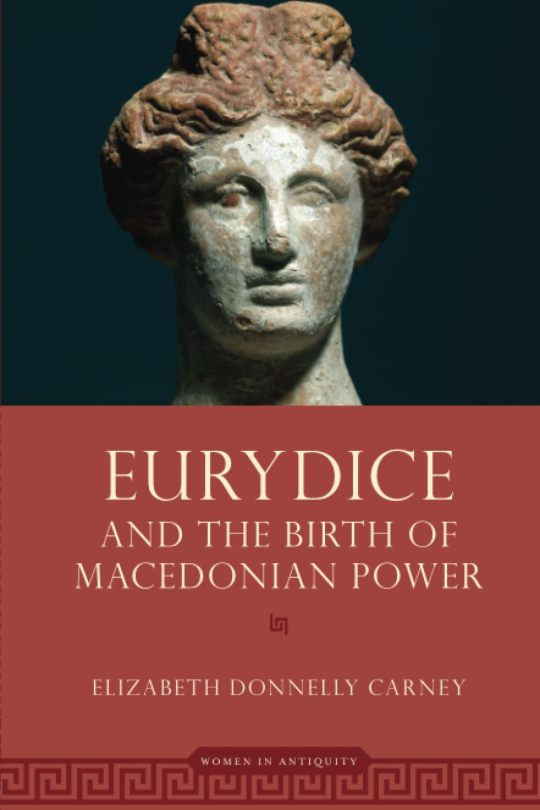
Yet where I want to begin isn’t with Eurydike, but with southern Greek male problems writing about (and understanding) Macedonian/Northern women. Basically, they didn’t “get” them.
Remember that, to southern Greek men, women should be neither seen nor heard. In his funeral speech, Perikles says (Thuc. 2.45.2) “…the greatest (glory) will be hers who is least talked of among the men whether for good or for bad” (Strassler). Even if that speech was made up by Thucydides (in typical Greek literary style), it still reflects what he thought Perikles might have said—and thus, reflects elite southern Greek values. (Thucydides and Perikles came from the same basic “class” in Athenian society: the military elite.) Athenians were among the more repressive societies for women in south Greece, but they still embodied general Greek ideas about women.
And women shouldn’t be involved in politics, dammit!
So, to the southern Greeks, those Meddling Macedonian Women were right up there with Meddling Persian Women—and both were bad, bad girls. (Never mind that especially Persian women were expected to be somewhat involved in politics, apparently….)
A few quick things on Eurydike herself. She belonged to the Lynkestian royal house; Leonnatos was apparently related to her, as was Alexander of Lynkestis. Her father’s name was Sirras, which isn’t a Macedonian name. It’s an Illyrian name. Her mother was the daughter of old King Arrhabaios of Lynkestis, who’d revolted against King Perdikkas II of Macedon—part of what got Brasidas of Sparta involved up there during the Peloponnesian War. Amyntas III had trouble with the Lynkestians as well, and his marriage to Eurydike may have been part of a peace deal.
While there’s no complete agreement that she’s half Illyrian, it’s more often accepted than not. If true, this might explain Eurydike’s tendency to “meddle” in politics. Illyrian women had power, and even fought. Famously, Kynanne learned arms skill from her mother Audata, and then taught her own daughter Hadea Eurydike. It’s really with Eurydike that Macedonian women began to assert themselves directly, rather than just influence brothers, husbands, and sons. Olympias is another example…and she’s from Epiros.
Culturally, Macedonia and Thrace appear to have shared a fair bit. Similarly, with Illyria and Epiros, at least when it came to women. So, it seems to me (and others, starting with Macurdy) that the rise of women’s influence at the court may have come from “outside” Macedonia. Eurydike is interesting as we have TWO quite different traditions about her.
....
And the rest may appear in the future in an article. But this should at least give some kind of answer to the asker. As much as I'd like to share my burgeoning theories, I need to chase down some additional material...and be sure Sabine hasn't beaten me to the punch. LOL
#asks#Eurydike I of Lynkestis#Philip II of Macedon#Amyntas III of Macedon#Macedonian women#Elizabeth D. Carney#Sabine Mueller#Kate Mortensen#Macedonian inheritance#Justin LIES#Classics#tagamemnon#Alexander the Great#ancient Macedonia
11 notes
·
View notes
Text

hey there, shay here with my primis vampire, DRU ! underneath the cut you’ll find her statistics and biography. i also have a pinterest board for her HERE. her connections can be found HERE and i’m always open for new ones ! she’s a little jaded from living in this world so long and loves to brag about having a signed manuscript from shakespeare himself. you can message me on this account or at 아기#0942 on discord !
BASIC INFORMATION
name: druscilla fidele agosti alias: dru age: two thousand and twenty four, looks twenty eight gender: cis-female, she / her pronouns religion: atheist orientation: homoromantic, pansexual species: primis ( original ) vampire
PERSONALITY
mbti: entp, the debater moral alignment: chaotic neutral enneagram type: the challenger, type eight positive traits: assertive, resourceful, protective negative traits: domineering, confrontational, intimidating
PHYSICAL APPEARANCE
hair color: chestnut brown eye color: green with an outer ring of aqua build: fine-boned, svelte height: 5'0" complexion: bisque with neutral undertones birthmarks: n/a scars: too many to count dispersed in a silver web across her body
RELATIONSHIPS
father: alaric agosti ( deceased ) mother: isolde agosti, nee beddow ( deceased ) siblings: severine agosti, corisande agosti, adlai agosti ( all deceased )
ABILITIES
intelligence: high physical strength: high supernatural powers: great strength, enhanced senses, speed, immortality
BIOGRAPHY
(TW: MURDER, RAPE, PROBABLE HISTORICAL INACCURACY)
Born in 5 BC, Druscilla Fidele Agosti was the oldest of four children born to Alaric and Isolde Agosti. Residing in Romania during the time of the Odyrisian Empire, stability was an unknown to their family. The Odyrisian Empire consisted of twenty-two kingdoms and over forty Thracian tribes and power was constantly shifting between various leaders and tribal elites. Power was fluid, easily won and lost as her father was to find out in 9 AD. He rose in ranks and became the royal adviser to Cotys IV. The king tried fervently to unite the now independent Canite and Oddrisae kingdoms in an attempt to bolster their borders against the growing power of Macedonia. The Macedonians, catching wind of this plot, sent out assassins to take out Alaric and Cotys IV. While Cotys IV and his family survived this attempt, Alaric Agosti and his family were not so fortunate. Druscilla awoke to find her family brutally murdered around her, her own body battered and torn by the assassin’s knife. She survived, a fact she would credit to the power of pure spite.
The prospects for an orphaned girl at fourteen in Ancient Romania were dismal, to say the least. It was to her great fortune that Cotys IV felt indebted to her late father and pulled the young girl into his own family. Rank and power she would not inherit, but the privilege and opportunities allotted to her within his walls more than made up for that. Druscilla was married at the age of sixteen to Zayraxes of Gacian in 11 AD. Their union was brief, Zayraxes was killed in combat with the Roman Empire in 19 AD. During that invasion Druscilla was brutally raped by Roman soldiers.
Widowed, childless, and sullied by rape, the rage that had been building in her veins since the death of her family boiled over. Over the course of the next four years Drusciilla made her way west towards the Great Roman Empire. It was there, penniless , sick and thirsty for blood, in 23 AD, that Drusiclla met the god who would alter the course of her life forever. Sensing the fury within the girl’s tiny frame, the witch offered her a deal. Kill a mark for her and Druscilla would live to watch the Empire who wronged her crumble. She was quick to accept the deal, sneaking into the Roman general’s home in the dead of night. Her hunger to avenge her family made for a swift and brutal death for the general, committing a murder not unlike the one that originally set her on this path.
Over the following days Druscilla laid in agony as the blood thirst took hold and her skin burned and withered under the light of day. Her eyes, once green, went black with hunger. Within the first couple of months of her transition Druscilla killed tens of men in her attempts to satiate the need for blood. This number would only grow higher as the god’s promise came true and she slowly watched as the Roman Empire fell around her.
With her newfound immortality came a freedom the likes of which she had never experienced. Druscilla wandered the growing European world over the next couple of centuries taking lovers of all genders who aged in the blink of an eye and slowly becoming a learned woman in the secrecy of the night. She avoided staying in any place long enough for the citizens to catch on to the fact that she never aged and was careful not to accumulate too much rank in society. Some highlights of these years include disguising herself as a doctor during the Black Plague of England (those bird masks proved useful for something), meeting William Shakespeare in 1586, cloth-making during the years of Reformation, coming to America with the Puritans in 1648, preying on Confederate soldiers during the Civil War and marching for the right to vote in 1913.
After taking some time to cool off from way too much fun during the Summer of Love in Haight-Ashbury, Drusiclla moved to London in 1980. The thriving city held no interest to her until she began hearing whispers of supernatural beings being drawn there.
2 notes
·
View notes
Text


Ross Lynch as Alexander the Great of Macedonia and his Brahminy kite daemon, Isodalis.
Alexander inherited the Macedonian throne after the assassination of his father, Philip II. During a period of 13 years, he conquered the powerful Persian Empire and expanded his kingdom all the way to India. He is remembered as a military genius and is credited for the spread of Greek culture across most of the ancient world.
Brahminy kite daemons represent courage, determination, and resilience.
8 notes
·
View notes
Photo





Tarn has striking said: “If Macedonia produced perhaps the most competent body of men the world had yet seen, the women were in all respects the men’s counterparts.” Yet in spite of the notable achievements of women, which Tarn summarizes in his following sentence, the truth is that very few of the queens in Macedonia and in Seleucid Syria possessed any political power at all and that only gradually in Egypt did a woman become the equal of a man as ruler.
From the latter part of the fourth century B.C. for about three hundred years before the Christian era women of Macedonian blood in the Hellenistic kingdoms established by the Successors of Alexander the Great showed a remarkable capacity for ruling in the manner of the kings of whom they were wives and daughters. They possessed to an extraordinary degree, “greater than the measure of women”, as is said of them in ancient historians, the qualities of energy, political foresight, daring, and courage which distinguished the men who took the world in their hands after Alexander’s death. These women had great prestige and influence and in some case great political power, though this last did not come to them as it came to the men by direct inheritance or by conquest, but through the doorway of marriage, which often afforded them opportunity to act as regent for an absent husband, or for a minor child, or as co-regent with a husband whose weakness of character allowed a queen of strong nature to come forward as co-ruler. If, as happened in the last period of the Lagid rule in Egypt, the throne came to a daughter in default of male heirs, a husband as closely connected as possible with the reigning house was sought with all haste as consort for the queen.
The influence of these queens upon the events of their times and the history of their countries was very great. The earliest Macedonian woman to take a part in political affairs of whom history tells is Eurydice, mother of Philip the Second, the last is the famous Cleopatra VII of Egypt. Cleopatra has never lacked historians, poets, and dramatists to tell the story of her life, but many of her predecessors are all but completely ignored by historians ancient and modern and are, when mentioned, often condemned en masse as unscrupulous, cruel, and wanting in all the gentler virtues […] The crime of which they are accused are dynastic murder and infidelity to their marriage vows. Tarn however has noted the fact that they were not licentious; – “no lover is anywhere recorded” for the third century queens. Those whose actions appear most culpable followed in their feminine way the rules of political procedure established and observed by kings whose cruelties are often condoned by the words “political necessity”. Among these queens are some women notable for loyalty and kindness and others whose lives were lived in quietness, of whom we know little or nothing except that they were the wives of kings. It has often been noted that especially among the Lagids in Egypt the queens remained vigorous and capable at a time when the kings were degenerate and worthless.
--- Grace Harriet Macurdy, Hellenistic Queens: A Study of Woman-Power in Macedonia, Seleucid Syria, and Ptolemaic Egypt
#hellenistic queens#tagamemnon#ancient greece#Classical Macedonia#seleucid syria#ptolemaic egypt#Hellenistic Age#history#female rulers#greek history#Classics#women in history
27 notes
·
View notes
Note
Something that’s been on my mind for a bit that your professional word may be able to help with. Would you happen to know how ethnically diverse the Greek and Roman empires were?
very
next question please
…
…what, you want more? Oh, fine, but for the record this is not the sort of thing people just “happen to know.”
Okay so I’m assuming by “Greek empire” (remember, kids: there was never a politically autonomous and unified state called “Greece” or “Hellas” until 1822) you mean Alexander’s empire (320s BC) and the Hellenistic successor kingdoms (323 BC – 31 BC), and by “Roman empire” you mean Rome starting from the time it becomes a major interregional power (say, following the second Punic War, which ended in 201 BC) rather than just Rome in the time of the Emperors. You could spend like most of a book on each of these just corralling the data that might let us answer this question, but whatevs.
Lesson one: the ancient Greeks and Romans did not think about ethnicity in the same way as we do. In particular, they were not super hung up on the colour of people’s skin – skin colour in ancient art is more often a signifier of gender than race, because women are expected to spend less time outside and therefore have lighter skin (which is another whole thing that we shouldn’t even get into because this is an aristocratic ideal of female beauty and of course lots of Greek and Roman women would have worked outside). Arguably the most important signifier of ethnicity to the Greeks and Romans was actually language, with everyone who didn’t speak Greek or Latin being a “barbarian” (traditionally this word is supposed to come from the Greeks thinking that all foreign languages sounded like “bar bar bar,” although I’ve also heard a convincing argument that it comes from the Old Persian word for taxpayer, barabara, and originally signified all subjects of the Persian king).
In the modern world we have designations of ethnicity that are super broad and grow in large part out of early and long-since-debunked anthropological theory that divided humanity into three biologically distinct races, Caucasoid, Mongoloid and Negroid, and don’t really reflect a lot of important components of ethnicity. The thing is, as the internet will happily tell you ad nauseam, race is a social construct. Like, yes, designations of race describe real physical characteristics that arise from variation within human genetics, but the way we choose to bundle those characteristics is arbitrary, and where we choose to draw the lines is arbitrary (like, for a long time in the US, Greeks and Italians weren’t considered “white,” but today they definitely are, even though nothing changed about their genetics). If we today were brought face to face with a bunch of ancient Greeks and Romans, we would probably be pretty comfortable with assigning a majority of them to the big pan-European tent of modern “whiteness,” but if you had asked them about it, they certainly would not have felt any kinship with the pale-skinned people of northern and western Europe from whom most English-speaking white people today are descended. Those people were every bit as barbarian (and every bit as fair game for enslavement, for that matter) as the darker-skinned folk of the Middle East and North Africa. Ancient Greeks and Italians also had loads of internal ethnic divisions – like, the Latins (the central Italian ethnic group to which the Romans belonged) were a different thing from the Umbrians to their east, the Etruscans to the north and the Oscans to the south. In Greece, you had Dorians in the Peloponnese, Ionians in Attica and Asia Minor, Boeotians and Thessalians in central Greece, Epirotes in western Greece, and DON’T EVEN ASK about the Macedonians, because boyyyyyyyyy HOWDY you are NOT ready for that $#!tstorm. The point is, race and ethnicity can be basically anything that you think makes you different from the people in another community.
So yeah, Alexander’s empire. Alexander the Great conquered Persia, which was already the largest empire the world had ever seen at the time and incorporated dozens of ethnically distinct peoples (including many Greeks of Asia Minor, some of whom willingly fought against Alexander) through a philosophy of loose regional governance and broad religious tolerance. Now, here’s the thing: Alexander had no idea how to run an empire of that scale. No Greek did. No one alive in the world did – except for the Persians. Alexander didn’t have anything to replace the Persian systems of governance or bureaucracy, so… he didn’t. Individual Persian governors were usually given the opportunity to swear loyalty to him and keep their posts; vacant posts were filled with Macedonians, but the hierarchy was basically untouched. Alexander himself married a princess from Bactria (approximately what is now Afghanistan), Roxana, and had a kid with her, and encouraged other Macedonian nobles to take Persian wives as well, to help unify the empire. Unfortunately Alexander, of course, had to go and bloody die less than two years after he’d finished conquering everything, and tradition holds that on his deathbed he told his friends that the empire should go “to the strongest,” which was an incredibly dumb thing to say and caused literally decades of war, which we are not even going to talk about because it is the most Game of Thrones bull$#!t in the history of history. All you need to know is that when the dust settled there were basically three major Greco-Macedonian dynastic powers: the Antigonids in Greece, the Ptolemies in Egypt, and the Seleucids in Persia.
In terms of ethnic makeup the Antigonid kingdom is in principle the most straightforward because they’re basically still running the same Greece that Alexander’s father had conquered. Even then, you should bear in mind that a) most Greek cities had legal provisions for allowing foreigners to live there under certain conditions (“foreigners” often meant Greeks from other cities, but in principle could be anyone), and b) the Greeks had a lot of slaves (many of whom were, again, Greeks from other cities, because that’s fine in ancient Greek morality, but a lot of them would have come from all over the place), and even though the Greeks didn’t count slaves as “people” or consider them a real part of a city’s ethnic composition, WE SHOULD. The Ptolemaic kingdom in Egypt seems to have had a relatively small Greco-Macedonian upper class ruling over a native Egyptian, Libyan and Nubian peasant majority. Members of that ruling class seem to have been kind of snobbish about any mixing between the two – only the very last Ptolemaic ruler, Cleopatra VII (yes, that Cleopatra), even bothered to learn the Egyptian language. However, the Ptolemaic rulers did make some important cultural gestures of goodwill towards the Egyptians. They took the native title of Pharaoh, which previous foreign rulers of Egypt hadn’t, and adopted a lot of traditional Pharaonic iconography like the double crown. They also worshipped some of the most important Egyptian gods, most notably Isis, and may have kind of… deliberately created a new Greco-Egyptian god, Serapis, by blending together Osiris and Dionysus (Serapis actually becomes super important in the Roman period and is widely worshipped even outside Egypt). And then there’s the Seleucids, an empire that did nothing but slowly collapse from the moment it was established. They have a rough time of it because they have the largest land area to cover and dozens of distinct ethnic groups to bring together, and it doesn’t help that they kinda keep doing the Game of Thrones thing for about two hundred fµ¢&ing years. They often get a bad rap in history and have a reputation for oppressing the non-Greek populations of their empire, but that’s probably at least partly because some of our most important sources for the Seleucids are Jewish, and the Seleucid kings’ relationship with the Jews broke down in a fairly spectacular fashion during the reign of Antiochus IV Epiphanes (r. 175-164 BC). It’s not clear whether that’s representative of the Seleucids’ normal relationship with their subject peoples, or a worst case scenario. Also, the Seleucids tend to get painted as villains in the historical record by both the other Greek powers and the Romans, and never really get much of a chance to defend themselves because we don’t have Seleucid histories. What is clear is that they inherited all the ethnic and religious diversity of the Persian Empire, and most of their rulers were half-Persian because they followed Alexander’s example by marrying into the Persian nobility. After an initial period of conflict they also seem to have maintained cordial relations with the Mauryan Empire of India, their neighbour to the east, for several decades, and contemporary Indian sources talk about sending Buddhist missionaries into Seleucid lands, so… like, there might have been a bunch of Greek Buddhists running around the empire; that’s a thing.
Whew. Okay, so that is a criminally brief answer to-
OH CHRIST YOU ASKED ABOUT THE ROMANS AS WELL
WHAT DO YOU PEOPLE WANT FROM ME
Right. Romans. One of the major schools of thought on how the Romans were able to create such an enormous and long-lasting empire in the first place is that their openness to accepting foreigners into their community gave them an enormous manpower advantage over every other ancient Mediterranean state. Greek politics generally operates on the level of cities; even in the age of Alexander, individual cities have quite a lot of legislative autonomy. Citizenship is also something that works on the level of cities: you aren’t a citizen of, say, the Seleucid Empire; you’re a citizen of Antioch, or Tyre, or Babylon, or whatever. But then the Romans happen. The Romans are weird, because they will sometimes just declare that all the people of an allied city are now also citizens of Rome. In the early period of Rome’s expansion in the central Mediterranean, this meant (or so the theory goes) that they could draw upon larger citizen armies and sustain more casualties than their rivals. This is how they beat Pyrrhus, the Greek king of Epirus (r. 297-272 BC), when he invaded Italy in response to disputes between Rome and the Greek colony of Tarentum; this is how they beat Hannibal, the legendary Carthaginian general, even after he annihilated the largest army the Romans had ever fielded at Cannae during the second Punic War (218-201 BC). Now, at this point they are basically still just bringing in Italians, which we might consider ethnically homogenous even if they didn’t, but there’s more.
Once they really start to get going, the Romans enfranchise entire provinces at a time, like when the emperor Claudius (r. AD 41-54) decided to make everyone in Gaul (modern France, more or less) a Roman citizen. The really interesting thing about this particular decision is that we actually have a copy of the speech he made to the Senate in Rome at the time, so we can examine his rationale. Claudius’ argument is basically that being inclusive has always been what has made Rome stronger than its rivals, going right back to their mythological past, when Romulus populated his city with disenfranchised criminals from other communities (and, uh… women that they kidnapped from the next town over). The Romans believed that everything great about their civilisation had originally been learned or borrowed from someone else – metalworking and irrigation from the Etruscans, infantry combat from the Greeks, shipbuilding from the Carthaginians, etc – so it wasn’t a huge stretch for them to believe that all these people should eventually become part of Rome as citizens (well… the ones who weren’t killed or enslaved in the conquest, anyway – no one ever said the Romans were saints).
The reason Claudius feels he needs to justify all this to the Senate is that citizenship (rather than any of the forms of semi-citizen rights that Romans would sometimes grant to their allies) will make rich Gauls eligible to become Senators themselves, and occupy other high-level posts like provincial governorships. The decision affects the ethnic composition of the Senate, so even though he doesn’t actually need their permission to do it, he asks as a courtesy (the emperors’ relationship with the Senate is a weird and complicated thing). Even without being a citizen, you could actually do a great deal in the Roman government in Claudius’ time. Many of the most important jobs in the empire were ones that had existed during the age of the Republic, when Rome was theoretically a democracy, and all of those were restricted to citizens even after they stopped being elected positions – but there was also an imperial bureaucracy that answered directly to the emperor and his aides, and he was free to choose literally anyone to fill those positions. As a result, a lot of emperors deliberately picked slaves and former slaves for loads of senior positions, specifically because their lack of citizen rights meant that they could never be political rivals, and because they were a useful counterbalance to the power of the blue-blooded Roman aristocracy. And, again, slaves can be from basically anywhere. A lot of these administrative slaves were Greeks, because Greek education provided useful skills for running the imperial bureaucracy that the Romans themselves often didn’t have, but emperors could and did commission literally anyone for these positions.
Eventually the emperor Caracalla (r. AD 211-217) just decided it wasn’t worth keeping track anymore and declared that every freeborn person in the entire empire, which by that point stretched from northern England to Morocco to Romania to Jordan, was now a Roman citizen. All of these people are now “Romans,” regardless of their language or culture or religion; the only criterion is that they not be slaves or former slaves (and even if they’re former slaves, their children will be Roman citizens). And these people can move, in ways that were never possible before the Empire existed, because Rome is the first – and so far the last – political entity ever to unite the entire Mediterranean region, which allows them to wipe out piracy almost completely and jump-start trade and travel in ways that would never happen again for over a thousand years. My own research on Roman glass has led me to encounter glassblowers with Syrian or Jewish names working in northern Italy – people who were probably integral to spreading the technology of glassblowing to western Europe. The Roman army also moves people around – like, a lot. You might enlist in your home town in Syria, then serve on Hadrian’s wall and retire in northern England – in fact, we know that this happened because we’ve found stuff like inscriptions in the Aramaic language in Roman Britain.
Also Rome had, like… a whole dynasty of African emperors one time. Septimius Severus (r. AD 193-211) and his successors were part Italian, part Punic (of Carthaginian descent – ultimately Middle Eastern, since the Carthaginians were originally a Phoenician colony) and part Berber (native North African), and Severus grew up in what is now Tunisia. And that wasn’t really a big deal for the Romans, 1) because Severus’ Italian ancestry made him a Roman citizen, which trumps all other signifiers of ethnicity, and 2) Rome had already had a couple of emperors of Iberian (= Spanish) descent by this point who were considered some of the best ever, and the Iberians are just as “barbarian” as the Berbers as far as Rome is concerned. Other Roman emperors of varied ethnicities include Philip (Arabian), Diocletian (Illyrian), the three Gordians (probably Cappadocian), and Elagabalus (Syrian, and incidentally the gayest Roman of all time; like, normally I would warn you to be super cautious about using modern labels like “straight” and “gay” for Romans because they just didn’t think about sexual orientation in those terms, but I make an exception here because Elagabalus was super gay).
Oh, and just because someone will definitely bring it up if I don’t, there was a big fuss in the news a few years back because someone discovered the skeletons of what they claimed were Chinese people living in, of all places, Roman Britain. And to me, one Chinese family in Britain in the first century AD is not particularly a dramatic stretch of plausibility (a handful of people could easily slip through the historical record and just never be mentioned), but the evidence in this particular case falls some way short of “proof.” There’s chemical data that suggests these individuals grew up somewhere far away from Britain, which is well and good, but the thing that points specifically to China is not the isotopic analysis but a study of bone morphology, and trying to determine someone’s ethnicity on the basis of what their bones look like, on the universal scale of things that are sketchy, ranks “sketchy as all fµ¢&.” Again, I’m happy to believe that they exist, because China (Seres in Latin) and Rome (Dà-Qín in Chinese) definitely knew about each other, and we occasionally find Roman artefacts and coins in eastern Asia, or Chinese artefacts in the eastern Roman Empire, but the specific evidence for these individuals isn’t there, in my opinion.
…that was a brief answer. Let it stand as a warning to others.
932 notes
·
View notes